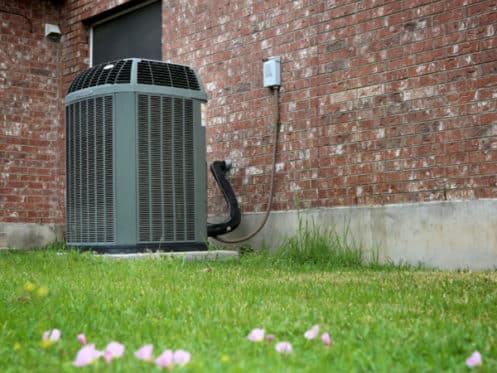You’ll commonly see BTUs and tonnes listed as specifications for air conditioners when shopping for a new unit. Both of these measurements refer to the same thing, which is the size of the air conditioner. Use this guide to understand BTUs and what’s involved in determining what size air conditioner you’ll need.
Understanding BTUs and Air Conditioner Sizes
BTU stands for British Thermal Unit and is the measure of how much heat an air conditioner can transfer. A single BTU is equivalent to the amount of heat needed to raise one pound of water one degree Fahrenheit.
A tonne or ton is another way of representing BTUs with smaller numbers. One ton is equal to 12,000 BTU. So if you need a unit that’s 33,000 BTU, that would be 2.75 tons. Depending on where your unit was manufactured, you may see it listed as tonnes.
Air conditioner size is important because you need the right capacity to properly cool your home. An oversized unit will short cycle, whereas an undersized unit will run constantly. In both cases, you add wear to your system, leading to more frequent repairs, a shorter service life, higher energy bills, and never achieving the comfort you desire. The following are the variables that affect what size AC you’ll need to properly cool your space.
Serviceable Square Feet
The square feet you need to cool will always be the foundation for the size unit you need. However, only considering the number of square feet you’re trying to cool will often leave you with the wrong size unit.
If you’re cooling a single room, the serviceable square footage is simple to calculate in most circumstances by multiplying the length by the width of the room. However, measuring your entire home is a little more complicated. You need to account for serviceable areas that may not have a vent, like hallways and stairwells. You also need to see if uncommon areas are serviced by the system, such as your attic, basement, or garage.
Ceiling Height
Ceiling height is critical to understanding the actual amount of air your system needs to cool measured in cubic feet. Keep in mind that some rooms may not have a single ceiling height, which makes the calculation a little more complicated.
The rule-of-thumb calculation you may see is 20 to 25 BTU per serviceable square foot in your home. However, this rule only allows for the standard 8-foot ceiling. If you have taller ceilings, such as a 12-foot vaulted ceiling, your system will end up significantly undersized. As an example, take a simple 10-foot-by-10-foot room. The simple calculation would effectively service 800 cubic feet. However, if that room has a 12-foot vaulted ceiling that is 1,200 cubic feet, which is 50% more air to cool.
The Building’s Insulation
Beyond the amount of air that needs cooling, you have to consider the factors that affect how the space transfers heat. The better insulated it is, the less heat it’ll transfer with the air outside. For your air conditioner, this means that it doesn’t need as much capacity to keep your home cool.
You’ll need to evaluate both the wall insulation as well as any attic insulation. In Lancaster, the minimum recommended attic insulation is R30, which is 8.25 inches of standard fiberglass batting insulation, or 10.25 inches of blown-in insulation. Floors should have at least R13 insulation, which is just over 6 inches thick.
Number and Orientation of Windows and Doors
Your doors and windows also play an important role in how your home transfers heat. Generally, the more windows you have, the more heat they will transfer in and out of your home. The type of window construction, size and coatings they have may affect how much heat they are able to repel.
In addition to the number and type of windows in your home, the way they face may also play a role in how much heat it transfers. West and southerly-facing windows tend to allow more radiant heating than northerly or east-facing windows.
The number of exterior doors on your home also affects how much heat is transferred between your home and the air outside. While you may have the door sealed, opening and closing it will allow massive transfer during those transitions. Your AC size must account for cooling your home after doors open and allow in heat.
Heat Producing Appliances
Today’s homes have a variety of heat-producing appliances, both in the kitchen and elsewhere. The normal appliances may include an oven, range, dishwasher, refrigerator, washer and dryer. However, your home may also have other heat-generating appliances like high-powered computing equipment, coffee makers, toasters, air fryers, pressure cookers, electric or gas fireplaces, or a dehumidifier.
The more things in your home you have producing heat, the more capacity your AC will need. A professional installation technician will account for all of these appliances and will consider what’s seasonal and may not affect the AC, such as an electric fireplace.
Number of Occupants
Every person in your home also produces heat that needs consideration, especially during the summer when you need to cool your home. When accounting for people in your home, it’s not just how many people you have in your family. However, if you have people over frequently, you need to account for the total number of people who are frequently in your home. This is especially important if they are there during the heat of the afternoon.
How Much Shade the House Receives
The exterior environment also affects your home’s cooling needs. For instance, if your home is in full shade all of the time, it won’t heat up as much and therefore won’t need as much cooling capacity. However, if it’s in full sun with other buildings reflecting more light on it most of the day, you’ll need more capacity to keep the inside cool.
Sizing a Single Room
Sizing a system for a single room is a bit different than sizing a system for an entire house. If you’re instituting a single window-mounted unit or a ductless wall-mounted air conditioner, you can use the square foot calculation. Carrier recommends multiplying the room’s square feet by 25 to get the BTU for the space. However, wide-open west-facing windows or high vaulted ceilings will require more cooling capacity. Working with an AC installation professional will ensure you get the proper size to effectively cool your target room.
People around Lancaster have trusted Affordable Air & Heating to help them find the right air conditioners for their homes for more than 25 years. Our expert technicians provide heating and air conditioning installation, repairs and maintenance as well as indoor air quality solutions. Call to schedule your air conditioning consultation with one of our friendly installation experts. We’ll help you find the size of system you need for your home, and then we’ll install, repair and maintain it for you too.




